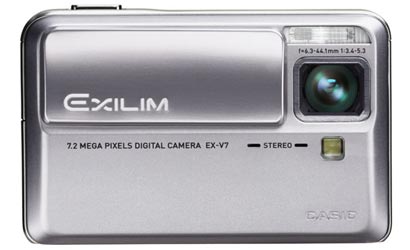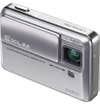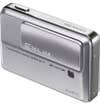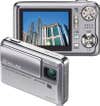Camera Review: Casio Exilim Hi-Zoom EX-V7
Who says point-and-shoot cameras have to have wimpy little zooms? See how the Casio EX-V7's 7x optical zoom fares in our hands-on review.

We may earn revenue from the products available on this page and participate in affiliate programs. Learn more ›
If you’ve read any of my previous reviews, you’ll know that one of the many “themes” I have is that point and shoot cameras need to have greater zooming power. In many instances, you’ll typically see a (3x) 30-something to 100-something millimeter (35mm equivalent) range lens. And while I’ll be the first to admit that this is useful, it’s also limiting.
For example, you’re at your kids’ baseball game and you want to get a shot of them from across the infield. You pull out your point and shoot camera and they take up about 1/10th of the frame. And sure, you can crop that down, but the resolution (and in many cameras, the noise) makes for a less than stellar image of your future big-leaguer.
Until now, the only real answer has been to walk around to the other side of the field and shoot. But, what if the light’s wrong on that side, or you have to shoot through a fence? Up until now, this has meant a compromise for the casual photographer who wants the greater magnification zooms in a smaller package. In virtually every camera line, this has meant a choice between smaller camera sizes or bigger, bulkier cameras that have a stronger “reach” because of their more robust optics.
Just when you’re about to give up hope, in walks Casio, who at January’s CES show, announced that they are making a statement about wimpy little zooms on point and shoot cameras. The 7.2 MP Hi-Zoom Exilim EX-V7 (street $ 400) fits in your shirt pocket and is the latest in Casio’s line of slim, sleek point and shoots. But, unlike the ultra-slim competition, the EX-V7 has a 7x (38-266mm f/3.4 – 5.3 35mm equivalent) optical zoom and a host of other features that make it an attractive option for those who want great features in a small package.
| What’s Hot • 7x Zoom • Multi-redundant shake technology • Improved image processing • Interesting Scene Modes • Zoom capable video • Stereo sound recorded to video What’s Not • Hot/Cold menu design • Poor control layout • High noise level in images • Highly limited “Manual” exposure mode • On/Off bar makes it easy to smudge the lens • Slow maximum aperture • Product Gallery • Image Quality Gallery • Rate this Camera |
According to Casio, the EX-V7 has the highest magnification zoom in a slim-series camera. Casio accomplishes this by using an internally zooming lens paired with a mirror along the width of the camera. The result is that the camera has no protruding zoom lens and maintains a very small size at all focal lengths. The camera also features a 2.5-inch Viewfinder/LCD screen that has a respectable 230,400 pixels and is quite bright and clear in all viewing conditions. Casio has also placed its new Exilim Engine 2.0 processor into the EX-V7, giving enhanced tracking for autofocus, more saturated colors, faster processing and the ability to selectively eliminate noise — particularly in areas such as the sky, where it can be most problematic.
The camera is small, even by compact standards. The EX-V7 stands at a slight 25mm thick, or about 0.7 of an inch, and is similar to a Palm Z22 PDA in overall dimensions. The camera feels solid and has a highly brushed silver finish with less-brushed accents and a highly polished chrome band that travels the perimeter of the camera and surrounds the shutter release button, which is conspicuously alone atop the camera. This is because all of the other controls, including the zoom toggle, are on the back right quarter of the camera. I had to wonder why Casio would move the zoom toggle from the top to the back because it just seems like it was placed so arbitrarily. To make matters worse, the zoom toggle moves up and down rather than the more traditional side-to-side. The end result is that this is less than intuitive for the user and makes the zoom lens control foreign and uncomfortable. Other controls on the back are more traditional, and I even liked having the function dial on the back of the camera with the other controls. And to be fair to Casio, it does make choosing your settings easier simply because all of the dials, displays and buttons are oriented in the same direction and are grouped together. In theory, I think this is desirable, but in actual practice, it’s less than convenient.
The front of the camera is similar in design to the Sony DSC-T10 and likewise uses a bar to turn the camera on and off. Unlike the Sony, the Casio’s bar moves from side-to-side rather than up and down and the first time I turned the camera on, I smudged the lens quite badly. There’s also a difference in the feel of the bar on the Casio in comparison to the Sony. In the Casio, you can feel the spring changing from a push to a pull as the bar moves, which isn’t the case for the Sony, which feels much more solid.
Because of its small size and high zoom magnification, the Casio can be pretty shaky when you’re hand-holding and the zoom is fully extended to its 266mm optical limit. Casio has smartly designed four anti-shake features that all but eliminate this issue in the final image. The first is the camera’s CCD Shift System, which physically moves the sensor to counter the movement introduced by the user. The camera also incorporates Casio’s Antishake DSP technology, which raises the ISO and shutter speed to a level that will eliminate any shake introduced by the user. Additionally, Casio includes speed and vector analysis for moving targets. The camera will judge these and adjust ISO and shutter speed on-the-fly to compensate. In video mode, the Casio uses an electronic camera shake function that eliminates blur while shooting video. To test these technologies, I hand held the camera with my right hand only at the full 266mm optical limit and was amazed at the sharpness of the images (See the quality gallery for examples). All of this stability comes at a price though, and one of the annoyances is that there is often a lot of shutter lag because of the antishake technology. In most situations, this isn’t a deal breaker, but if your shooting sprouting leaves on a tree, and the wind is blowing, you’ll miss many shots.
Casio also has what it calls “Best Shot” modes — a typical feature on point and shoots. These are 33 scene modes that are preprogrammed into the camera and cover a wide variety of situations. Most are quite typical, but a few did offer some nice surprises. The eBay mode, for example, gives the user a lower resolution image that’s ideal for images used by this auction portal. There are also the “Business Card” and “White Board” modes, which correct the perspective of either of these so that when viewed in the final image, they are completely square. So, even if you photograph a business card at an extreme angle, it views as being photographed perfectly flat and parallel to the camera when shot. Nice. In the “Collection” mode, it automatically switches the camera to a macro focus and displays a really nice grid system on the LCD screen while composing the image. And the one that I had the most fun with was the “ID Photo” mode. This sets the camera up to shoot a head-and-shoulders image. After the shot is made, a circle displays over the image you’ve just made. With the cursor dial located on the back, lower right side of the camera, you move the circle until it is evenly placed around the subject’s face, hit select and then the camera makes five different sized images of your mug shot in one frame. It’s one of those features that you may use only once or twice, but when you need it, you’ll be glad it’s there. There were other more ordinary modes and some of them seem quite repetitive. For example, there’s a “Portrait” and a “Landscape” and then a “Portrait WITH Landscape”. Another example of this is the “Sports” mode and the “Splashing Water” mode, which says that it freezes action. Aren’t these basically the same thing? To Casio’s credit, they have given a great description of each scene and how the mode works. Some, for example, add in color filtration to enhance the scene. It’s nice to know this ahead of time if you’re one of those people who insist on perfect color. And if that’s you, the EX-V7 has several white balance modes as well, including manual white balance.
The EX-V7 also has a aperture priority, shutter priority, and a manual mode that offers a limited amount of adjustments, a “snapshot” mode and an “Easy Mode,” which is fully automatic, setting ISO, aperture and shutter speed. Ironically, the “Easy Mode” is denoted on the dial as a four-leafed clover — we can only assume that this was chosen because you’re lucky if you get a noise-free, in focus shot in this mode! To say that it wasn’t our favorite by a large margin is accurate. Additionally, Casio has designed in what it calls “Manual” exposure. For the most part, this is really not true manual exposure. Yes, you can choose the shutter speed and aperture independent of each other, but the ISO and other settings are controlled by the camera and those settings that it does allow are not the full range that’s available in the automated modes. For example, if you’re manually setting the aperture, you have a minimum aperture of f/9, but in the automated modes, it goes to f/11. I also found nothing outside of the histogram that would work as a light meter, which I found unusual in a camera that offers some degree of creative exposure control.
The EX-V7 also records video in the H.264 encoding method. In non-geek speak, this allows the user to shoot 1.5 times longer than MPEG4 video in the same amount of storage space, but is comparable in quality. The Casio surprised me by also having the ability to zoom while shooting and records sound in stereo as well — two really nice features that will surely enhance any video shot with this camera. The sound is also recorded in a WAV format, making for easy sound editing by any video editing program. Unlike many other cameras that shoot video, the EX-V7 also has a “Scene Mode” for video. My favorite is the “Silent” mode. This is a monochrome mode that has no sound and a slightly faster speed to give video shot in this mode an old-fashioned silent movie look and feel. It would be even better if Casio would design in dust, scratches, faded frames and processing marks to make it truly authentic!
As for the EX-V7’s menu, I found that I have a love-hate relationship with it. There are some parts that are so well thought out that it’s mind-blowingly simple to use. Yet, other features such as formatting and basic shooting adjustments are buried deep in the menu. It would be so nice to have those menu items you use regularly grouped into one screen and make that the first screen in the menu. Format, delete, white balance and ISO along with a few others would make operations much simpler if they were organized with the end user and how often they’ll use these functions in mind.
Another feature that I both liked and hated was the recharging cradle. This device acts as the recharger, USB port and photo viewer. The camera sets on a small, thin metal contact strip that seems like it could be very easily damaged if the camera were not set on it correctly. I really like the idea of a cradle, but the interface with the camera needs to be sturdier. I am anticipating Casio fielding calls about what the customer needs to do to replace the cradle. At the very least, it would be good to give the user an alternative to the cradle for the simple tasks, like recharging the battery. This way, even if the cradle does break, you can still charge the camera and use it with an SD card reader attached to your computer.
As you can see, there are many things to like about the EX-V7, but like many cameras in this category, its Achilles heel is image quality. Like many manufacturers, Casio has chosen to up the mega-pixel count and consider the image degradation issues as an afterthought. Unfortunately, the EX-V7 is quite noisy. Even at low ISO speeds, I can enlarge the full resolution image to 200 percent and see what I can only describe as “Noise blobs” throughout the image. It’s pitiful, really. And at $400 a copy, this becomes a camera that’s on the expensive side of the pocket-sized market and because of that high price tag, better image quality should be a given. With all things outside of image quality considered, I’d give the Casio an easy “A.” I like the zoom ability while shooting video, the redundant anti-shake technology, the much improved zoom magnification and the innovative approach to the various scenes in the camera. But, if the image quality is thrown into that mix, the camera earns only an average “C.” And when you consider that for only $100 or so more you can get a DSLR with a lens, the Casio then starts to fade off into the forgotten.
In the Box: USB Cradle AV Cable AC Adaptor Strap CD-ROM Printed User Guide Lithium Ion Battery (Casio NP-50)
Specs: 7.2 MP 11.6MB internal memory 95.5 x 59.8 x 25.1 mm weight 149 g (No battery)

Casio-Exilim-Hi-Zoom-EX-V7

Casio-Exilim-Hi-Zoom-EX-V7

Casio-Exilim-Hi-Zoom-EX-V7

Casio-Exilim-Hi-Zoom-EX-V7

Casio-Exilim-Hi-Zoom-EX-V7

Casio-Exilim-Hi-Zoom-EX-V7